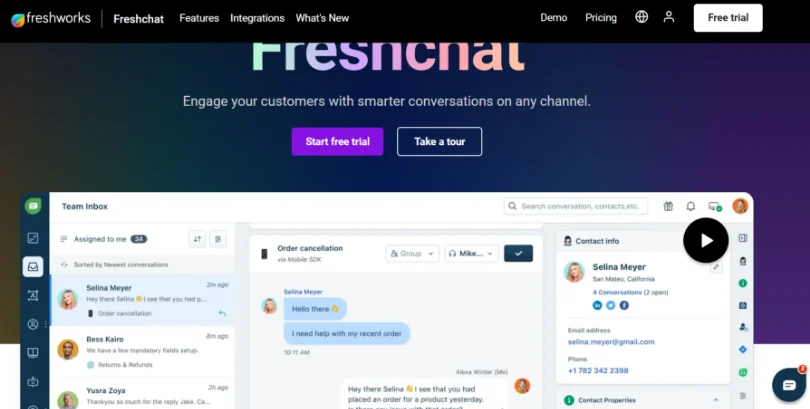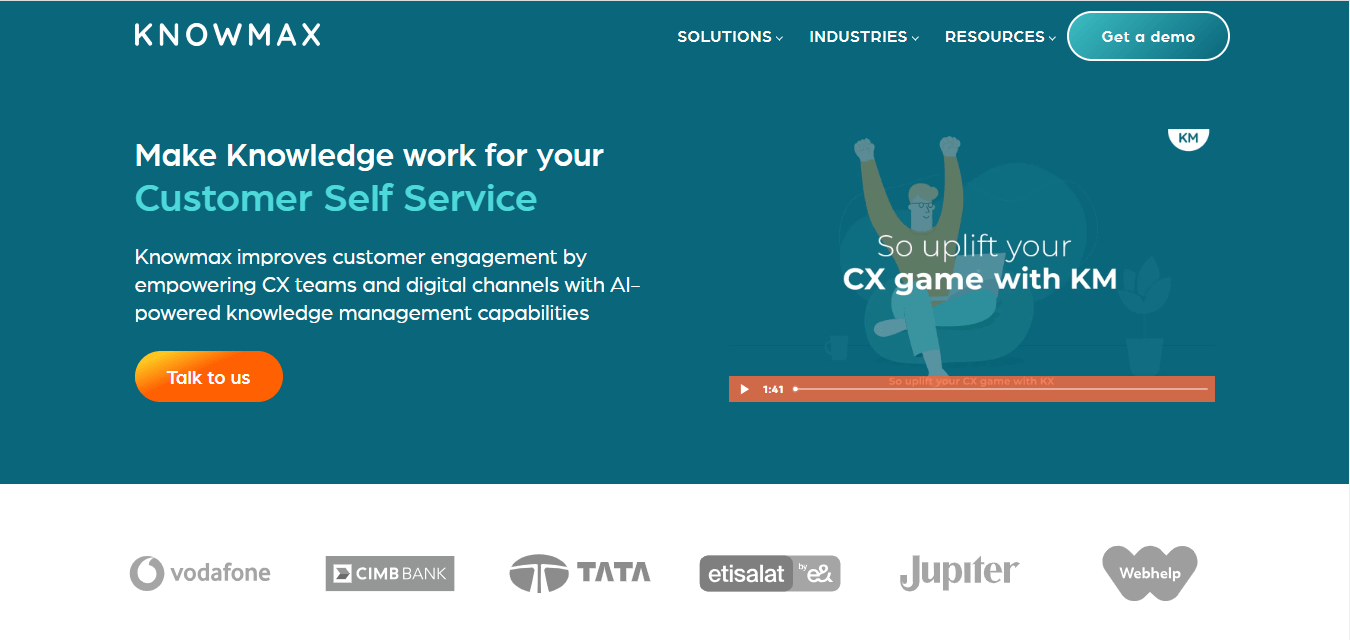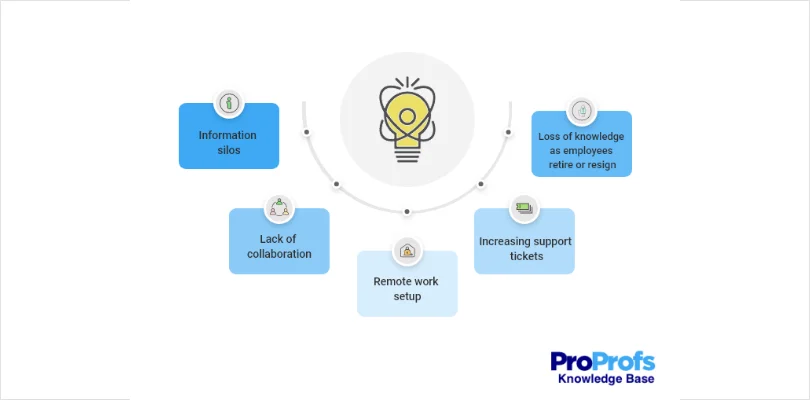
Welcome to the world of knowledge management!
They say knowledge is power, but without proper management, it can become a burden.
Picture this: your company’s valuable information is scattered across emails, Word docs, and Google Drive and is growing exponentially as your business expands.
Forget about leveraging this information for business growth, employees even struggle to access this data when they need it the most.
Fear not, for we have just the right solution to this problem!
Introducing knowledge management software – your key to unlocking the untapped potential of your business knowledge. With this powerful tool, you can foster a culture of collaboration in the workplace, improve work efficiency, and drive your business growth.
If you are looking for the perfect knowledge management software, you’ve landed at the right place. This blog will delve into some of the remarkable benefits of knowledge management software and shed light on why savvy businesses are increasingly investing in it.
Plus, we’ll unveil the top 15 tools to supercharge your knowledge management initiatives.
Ready to harness the power of knowledge? Let’s embark on this enlightening journey together!
What Is Knowledge Management Software
Knowledge management software is a tool that helps you capture, store, and access business information from a centralized platform.
This information can include business processes, company best practices, standard operating procedure software, and client details – basically, anything your employees need to give their best shot at work.
These tools encompass powerful features that facilitate instant search and smooth navigation across devices, including mobile phones. Moreover, with advanced analytics and multiple language support, knowledge management software lets you gather useful business insights and serve a diverse audience.
Best Knowledge Management Software & Tools for 2024
There are numerous knowledge management tools out there, promising stellar performance and great results. Despite that, choosing one tool is such an ordeal.
That’s because not every tool is the right fit for your unique business needs. To find the right one, you have no choice but to spend hours scouring websites and review platforms, and this can be a headache, especially if you are short of time and resources.
Fear not, as we have done all that hard work and collated a list of 15 best knowledge management software that are popular on the market today.
Have a look.
ProProfs Knowledge Base

ProProfs Knowledge Base is a simple and versatile tool designed to help you manage your business knowledge on a centralized platform. It comes with a user-friendly interface and a range of powerful features that enable easy content creation, quick searchability, and collaborative authoring.
There is a range of beautiful templates you can pick from to get started, set workflows to maintain article quality and evaluate self-service patterns using the tool’s advanced reporting system.
Key Features:
- Create compelling content using an MS Word-like editor
- Boost team collaboration through internal comments
- Enhance security using password and security controls
- Manage users, their roles, and permissions for collaborative authoring
- Integrate with tools like Slack and Jira for enhanced support
Pricing: Starts from $49/author/month (Single plan with all premium features)
Best for: Creating internal and external knowledge base, custom workflows, in-depth reporting
Document360

Designed for growing companies, Document360 brings all your company knowledge under a single roof for easy dissemination. The tool allows private access through a secured login so that only authorized members can use your document.
Along with a user-friendly interface and a robust search system, Document360 also offers content localization and advanced analytics, thus promising a top-notch experience.
Key Features:
- Get multiple versions of articles and closely track all changes.
- Translate your help content into a language of your choice.
- Manage the workflow process by setting due dates and roles.
- Export knowledge base content in PDF format.
- Get a real-time preview of the content as you write in the editor.
Pricing: Starts from $131/project/month
Best for: Category management with simple drag-and-drop UI.
Bloomfire

Bloomfire is another best knowledge management platform that helps you leverage your biggest strategic asset – knowledge. You can use this tool to build a central, searchable platform where your teams can work together and access information in an instant. With comments, likes, and a personalized feed, Bloomfire keeps users engaged and aids collaboration on projects.
Key Features:
- Find knowledge gaps and track search trends using built-in analytics.
- Tailor the platform to your unique needs with custom branding.
- Publish knowledge as videos, text, charts, audio, or any other format.
- Get instant information through automated tagging and AI-powered search.
- Bulk import/export content and keep your knowledge management system up to date.
Pricing: Contact the company to get a quote.
Best for: Cloud-based knowledge management, AI-powered search, Rich publishing.
Guru

Guru works as a company wiki that assists in employee onboarding and internal communication. The tool blends seamlessly with your workflows and offers powerful browser extensions that allow employees to capture information on the go. Guru’s native integration with Slack allows you to capture subject matter expertise and keep teams updated about any changes in your knowledge base.
Key Features:
- Write from scratch or import existing content using a simple editor.
- Capture information across the web and turn it into bite-sized cards.
- Organize information systematically in collections and boards.
- Gain deep insights into how knowledge is being used by your employees.
- Detect duplicate content to prevent redundancies.
Pricing: Starts from $5/user/month.
Best for: Internal company wiki, native Slack integration, AI-powered duplication detection.
Atlassian Confluence

Confluence is one of the top knowledge management tools that provide a remote-friendly workspace where your teams can get work done together. Using this tool, you can build a single source of truth by harnessing the subject matter expertise of different teams. Confluence also offers an intranet that facilitates seamless communication by allowing teams to share announcements and give feedback.
Key Features:
- Get access to beautifully crafted templates and get started quickly.
- Closely track article history and compare different versions.
- Allow teams to collaborate with each other through in-line comments.
- Alert your teams about task updates through instant notifications.
- Get a personalized feed on your home page and stay updated with all the progress.
Pricing: Starts from $5.50/user/month.
Best for: Project collaboration, remote-friendly workspace, power-packed integrations.
Bitrix24

Bitrix24 offers an all-in-one workspace for team collaboration, customer relationship management, and project management. Its knowledge management solution is easy to use and can be accessed across devices, including mobile phones and laptops. You can even customize the knowledge base to your liking and integrate Bitrix24 with your favorite tools. Furthermore, the tool offers a dedicated mobile app to enhance the end-user experience.
Key Features:
- Control user access by setting roles and permissions.
- Customize the templates to blend with your company’s branding.
- Set password controls to allow only authorized users to access your knowledge base.
- Access your knowledge base across devices for on-the-go learning.
- Create standard and nested menus for easy navigation.
Pricing: Starts from $43/ 5 users/month.
Best for: Mind maps, social knowledge sharing, and cross-device file syncing.
HelpCrunch

HelpCrunch is one of the leading knowledge management tools suitable for small and large businesses. Its knowledge management solution is primarily designed for customer self-service and reducing the ticket inflow. It comes with a powerful visual editor for effortless content creation. Furthermore, the tool allows you to build search engine-optimized content that can be easily discovered by users.
Key Features:
- Add text, images, videos, and tables using the WYSIWYG editor.
- Get smart suggestions and find what you need in seconds.
- Turn negative reactions into positive customers with insightful reports.
- Optimize your content for search engines by allowing metadata editing.
- Customize your knowledge base with your favorite fonts, colors, and images.
Pricing: Starts from $12/month.
Best for: Live chat widget integration, SEO optimization, smart search.
Zoho Desk

Zoho Desk is essentially a help desk solution that also offers self-service capabilities. As a customizable knowledge management system, the tool allows you to tailor every element of your help center to your taste using HTML and CSS. The best part is Zoho Desk supports communities and forums, giving your audience a centralized platform to ask questions and share ideas.
Key Features:
- Control user access to your help center and ensure top-notch security.
- Allow users to submit tickets from within the knowledge management platform.
- Use meta titles and keywords for search engine optimization.
- Monitor users’ search patterns and engagement levels with built-in reports.
- Auto-suggest relevant articles and help agents resolve tickets faster.
Pricing: Starts from $9.70/agent/month.
Best for Built-in ticketing, user forums, communities, and conversational assistant.
Zendesk Guide

Zendesk Guide is an easy-to-use knowledge management platform with advanced search functionality and powerful customization. Creating help articles is simple with its WYSIWYG editor, which offers various editing and styling options.
Multiple users can collaborate and work together on articles to speed up the process and ensure flawless content quality. The tool also allows content localization in over 40 languages to help you serve a diverse audience.
Key Features:
- Tailor the knowledge base with customizable themes.
- Get AI-powered article recommendations right inside support tickets.
- Get suggestions on which content works best for your audience.
- Create and update reusable content across multiple articles.
- Easily import content from different platforms and turn it into useful articles.
Pricing: Starts from $49/agent/month.
Best for: Ease of use, in-depth analytics, in-context self-service.
OpenKM

OpenKM is another tool for knowledge management that can efficiently manage your digital records and boost workplace efficiency. It is an open-source solution with enterprise content management features such as setting workflows and automating tasks. Using this tool, you can capture information from all digital sources and facilitate collaboration on different projects. Using API, you can integrate OpenKM with your favorite tools.
Key Features:
- Drag and drop files and documents to your knowledge base.
- Create, assign, and manage tasks using task manager.
- Build workflows for content review, approval, and validation.
- Access and restore previous versions of a document.
- Works with popular browsers like Firefox and Chrome.
Pricing: Connect with the company for a quote.
Best for: Digital records management, task automation, and document management.
Freshdesk

Freshdesk is a leading customer support tool with powerful knowledge management functionality. If you have a large team, you can use the tool’s approval workflows to build top-quality content that’s free of errors. The tool also offers answer bots to provide users with instant answers right inside the knowledge base. Freshdesk offers code-free customization and supports over 42 languages.
Key Features:
- Turn agent responses into meaningful help center articles.
- Increase knowledge base visibility through search engine optimization.
- Take bulk actions to update all your articles and folders.
- Keep a firm track of article performance based on user feedback.
- Publish content in the form of images, videos, or any other format.
Pricing: Starts from $12/agent/month.
Best for: Help widget, community forums, answer bots.
Tettra

Fed up with locating company knowledge scattered across documents? Tettra can be the right fit for you. It is one of the best knowledge management solutions that allows easy import of content from platforms like Google Docs and Dropbox. Its native Slack integration removes all the context-switching and provides teams with instant answers to questions right where they are asked.
Key Features:
- Get information verified and approved by subject matter experts.
- Create content quickly with Tettra’s simple editor.
- Get detailed monthly analytics to assess and improve content performance.
- Set up private categories to keep your knowledge base secure.
- Identify unowned and stale content to improve your knowledge management system.
Pricing: Starts from $8.33/user/month.
Best for: Internal knowledge management, integrations, content verification.
KnowledgeOwl

KnowledgeOwl is a popular software for knowledge management that requires no complicated procedures to set up. It is a fuss-free tool that helps you create product documentation and internal knowledge bases for both customers and employees. Using this software, you can drag and drop categories, build custom views, and take user feedback through comments.
Key Features:
- Add contact forms and allow users to submit feedback instantly.
- Edit files in your file library and instantly update articles.
- Manage content categories with a customizable table of contents.
- Categorize content using labels to make information gathering easier.
- Create a duplicate of your knowledge base for testing or rebranding.
Pricing: Starts from $79/month.
Best for: Global file management, advanced search, search engine optimization.
Nuclino

Nuclino is a modern yet simple tool that puts all your company docs in a unified space and allows teams to work together on projects. With a markdown editor, you can add text, images, and videos to your articles. The tool allows team collaboration through internal comments and suggestions. What’s really fascinating about Nuclino is that it allows you to visualize work with the help of lists, tables, and graph views.
Key Features:
- Auto-save and sync changes across devices.
- Undo changes and restore previous article versions.
- Write and edit content easily with drag and drop editor.
- Control who can edit and read by setting roles and permissions.
- Export content in PDF and Word formats.
Pricing: Starts from $5/user/month.
Best for: Real-time collaboration, unified workspace, work visualization.
ServiceNow Knowledge Management

ServiceNow’s Knowledge Base Software is designed to help you cater to both your customers and employees. It integrates with MS Word to give you a flawless writing experience and also provides useful insights into existing knowledge gaps. The tool comes with an AI-powered search system that provides personalized results, giving users a seamless information-gathering experience.
Key Features:
- Get rich insights into user feedback and gaps to fine-tune your knowledge base.
- Build an online community where customers and employees can stay connected with their peers.
- Assign articles to specific teams to ensure top-notch quality.
- Create reusable content blocks and reduce redundancies.
- Provide an uninterrupted and quick search experience to users.
Pricing: Contact the company for a quote.
Best for: Translation management, customer service management, IT service management
Knowmax

Knowmax is a CX-first (customer experience-first) knowledge management platform that delivers guided knowledge across assisted and digital channels. It is a single source of truth that extends beyond standard AI-backed knowledge base articles and FAQs to include advanced KM capabilities like interactive decision trees and visual how-to guides.
Knowmax integrates with your existing CX tools and channels, such as CRM, chat, telephone, etc., which empowers support representatives to access guided and contextually relevant knowledge within their workflow.
Its built-in micro-segmented analytics help you make data-informed decisions with insights into user search activity, top-performing content, and time spent on each piece of content.
Key Features:
- Semantic search for enhanced searchability
- No code, cognitive decision trees for SOP adherence
- Picture guides for step-by-step resolution through visual support
- Chrome extension to reduce screen toggle
Pricing: Contact the company for a quote.
Best For: Best for no-code Cognitive Decision Trees for mistake-proof customer service.
Top Features of Knowledge Management Software
How a tool performs depends largely on the kind of features it possesses. There are some prominent knowledge management features that a knowledge management tool must have for it to be useful for your business goals.
Let’s take a quick look at these features:
- Easy-to-use editor – An MS Word-like editor is essential for creating and editing the content. You can even use it to upload images and videos and style the content just the way you want.
- Access controls – This is a key feature that lets you manage user roles and permissions, paving the way for collaborative content creation.
- Internal comments – Using internal comments, users can initiate discussions on articles, give feedback, and stay on the same page with respect to an article’s development.
- Review workflows – You can set up a review workflow that comprises pre-defined article statuses. The workflow lets you stay in full control of an article’s progress from the time it’s written until it finally gets approved and published.
- Version control – You can manage multiple versions of your knowledge management system and ensure your employees have access to the latest edition.
- In-depth reports – With reports, you can get access to detailed insights into how your knowledge management system is performing and where it is lagging behind.
- Third-party integrations – External integrations with tools like Jira and Slack make the process of managing and accessing business knowledge even more effortless.
Why Is There a Growing Trend of Knowledge Management Software Adoption by Companies?
Gone is the time when knowledge used to sit silently in databases. With the emergence of technology, knowledge is now spread across emails, Google Drive, Slack, and various other platforms.
To ensure that this information is not lost in all the chaos and to and fro, more and more businesses today are looking to deploy knowledge management software.
In addition to this, there are several other reasons knowledge management is at the top of the priority list of companies today. Some of these reasons are:

The market is intensely competitive, with companies trying to outdo each other and break their own records. In such a scenario, the one thing that can keep you ahead of the curve is how well you manage and utilize your company’s knowledge assets.
In fact, research reveals that for 72% of organizations creating and preserving knowledge is crucial for their success.
Another important reason organizations are investing in knowledge management software is that they are aware of the tsunami of data being generated every single day. The sad part is a lot of this data – 55%, to be precise goes unused. This is a huge loss for organizations.
Knowledge management offers some ray of hope as it gives you a digital platform for the safe storage and retrieval of your business information.
Top Benefits of Knowledge Management Software
Deploying the right knowledge management software can unlock a world of opportunities for you that pave the way for improved productivity, creativity, and collaboration across your organization.
Let’s look the 5 key benefits you can glean from knowledge management tools:
Enhanced Collaboration & Creativity
Knowledge management software facilitates seamless collaboration, allowing teams to share insights, best practices, and lessons learned. It enables real-time communication through comments, encourages cross-functional collaboration, and breaks down information silos, fostering a culture of collective intelligence.
With teams getting a shared space to learn and work together, your knowledge management platform becomes a breeding ground for creativity and innovation.
Read More: Cross-Team Collaboration: Benefits, Best Practices, & Examples
Accelerated Learning and Training
Knowledge management software can prove extremely valuable for your learning and development initiatives. It equips employees with comprehensive training materials, e-learning modules, and interactive tutorials, ensuring they have on-the-go access to relevant knowledge.
As barriers to learning reduce, employees take less time to learn new skills and expertise in their respective fields. Moreover, they get adept with your company’s best practices faster and start contributing meaningfully to projects.
Aids Employee Onboarding
New hires have a tough time finding their footing in a new environment. Their learning process slows down if they are not provided with constant support.
A knowledge management system gives new hires quick access to all company information, so they can get up to speed faster. It accelerates their onboarding by giving a helping hand right when they need it and empowers them to overcome all initial challenges with ease.
This ensures that new hires have a smooth transition into your company and in their new roles.
Read More: Employee Onboarding: How to Use Your Knowledge Base Effectively
Improved Productivity & Decision-Making
With quick access to a centralized knowledge repository, employees can get work done faster without wasting time in emails, calls, and shoulder taps. They can make informed choices based on the data available, thus positively impacting the project outcomes.
Moreover, knowledge management software provides rich reports and analytics that empower leaders to extract valuable insights and make data-driven decisions for your company’s long-term growth.
How to Choose the Best Knowledge Management Software
Now that we are clear about the purpose and benefits of knowledge management software, let’s go one step further and understand how to choose it right.
There are hundreds tools for knowledge management on the market, which makes it all the more difficult to choose one that is perfect sync with your requirements.
We have an easy way out for you. Here are some of the key factors you should look out for during the selection process:
Ease of Use
While most of the top knowledge management software boast that they are easy to use, only a few fulfill this basic yet important requirement. The software you choose should have an intuitive interface and require no coding skills or specialized training to set up.
Centralized Platform
Any software you choose should provide teams with a unified space to work together and build high-quality content. This centralized platform is where teams can create structured content, track history, set workflows, and publish it across the web and mobile.
Data Security
While working with sensitive business data, you need a tool with a strong security system. The leading software for knowledge management offers smart security features that allow folder or page-level restrictions to hide or display content. Such tools also support single sign-on and are GDPR compliant.
Affordable Pricing
Knowledge management tools come with different price plans depending on the number of users and features offered. Go for a tool with a transparent pricing structure so that you don’t have to bear any surprises at the month’s end.
Free Trial
The tool should offer a free trial period of at least 15 days. This is vital for companies that want to take the product for a test drive before investing their hard-earned money in it. Moreover, a free trial period gives you a hands-on experience of a tool’s features and functionality, helping you make a mindful decision.
Evaluation Criteria
The evaluation of products or tools chosen for this article follows an unbiased, systematic approach that ensures a fair, insightful, and well-rounded review. This method employs six key factors:
- User Reviews / Ratings- Direct experiences from users, including ratings and feedback from reputable sites, provide a ground-level perspective. This feedback is critical in understanding overall satisfaction and potential problems.
- Essential Features & Functionality: The value of a product is ascertained by its core features and overall functionality. Through an in-depth exploration of these aspects, the practical usefulness and effectiveness of the tools are carefully evaluated.
- Ease of Use: The user-friendliness of a product or service is assessed, focusing on the design, interface, and navigation. This ensures a positive experience for users of all levels of expertise.
- Customer Support: The quality of customer support is examined, taking into account its efficiency and how well it supports users in different phases – setting up, addressing concerns, and resolving operational issues.
- Value for Money: Value for money is evaluated by comparing the quality, performance, and features. The goal is to help the reader understand whether they would be getting their money’s worth.
- Personal Experience/Expert’s Opinion or Favorites: This part of the evaluation criteria draws insightful observations from the personal experience of the writer and the opinions of industry experts.
Employ the Best Knowledge Management Software to Boost Innovation & Growth
Knowledge management is a key competitive differentiator that can keep your company ahead of the game.
With tons of data being generated every single day, you need a dedicated system to manage this information and make it easily accessible. When managed well, knowledge can prove to be a valuable asset that drives innovation, improves efficiency, and helps you build a positive growth graph.
The above-mentioned list of the best knowledge management software is carefully picked and will definitely help you make the most of your business knowledge. Compare their features and pricing, and opt for a trial version to check how well they perform.
If you are confused and need some recommendations, we’d say you can opt for ProProfs Knowledge Base if you need a tool that’s simple, feature-rich, and affordable at the same time. Give it a shot and watch how it can skyrocket your business growth.
FREE. All Features. FOREVER!
Try our Forever FREE account with all premium features!







